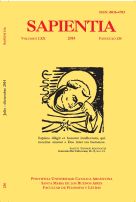Please use this identifier to cite or link to this item:
https://repositorio.uca.edu.ar/handle/123456789/4601| Título: | Redescubrir la finalidad natural : Robert Spaemann y Tomás de Aquino | Autor: | Clavell, Lluís | Palabras clave: | Tomás de Aquino, Santo, 1225?-1274; Spaemann, Robert, 1927-; TELEOLOGIA; NATURALEZA; TEOLOGIA; FILOSOFIA; TELEONOMIA | Fecha de publicación: | 2014 | Editorial: | Pontificia Universidad Católica Argentina. Facultad de Filosofía y Letras | Cita: | Clavell, LL. Redescubrir la finalidad natural : Robert Spaemann y Tomás de Aquino [en línea]. Sapientia. 2014, 70 (236). Disponible en: https://repositorio.uca.edu.ar/handle/123456789/4601 | Resumen: | Resumen: En ocasión de la autobiografía de Robert Spaemann aparecida en 2012, este trabajo examina la lectura que Spaemann hace de la teleología en la doctrina de Santo Tomás de Aquino, especialmente en su obra Natürliche Ziele (2005) que prosigue la versión de 1981. En la primera parte, se estudia la historia de la teleología en el pensamiento filosófico y científico expuesta en «Fines naturales». La finalidad intrínseca en la naturaleza de los seres es conocida con profundidad creciente gracias a Platón, Aristóteles, al estoicismo y a la tradición cristiana. Estos aportes se integran en una estructura teleológica unitaria en el Aquinate. Después acontece una «inversión» de la teleología centrada en la conservación del propio ser y una consideración de los fines como algo externo a la realidad. Con la teoría evolucionista surge la teleonomía que se limita a las reglas del dinamismo, suprimiendo el fin. Con todo, los científicos no logran eliminar los términos «con el fin de» o «para» en su lenguaje. Eso permite proceder a un redescubrimiento de los fines naturales. En la segunda parte, se ve cómo Tomás de Aquino lleva el conocimiento de la finalidad más allá de Aristóteles, porque ella remite a una inteligencia creadora. La teleología implica una teología, aunque no queda del todo claro si es la teología filosófica o la cristiana. Spaemann tiene un planteo ontológico de tipo persuasivo, pero en algunos momentos siente dificultad para superar en el plano teorético a quien se limita a una teleonomía. Abstract: On the occasion of the autobiography of Robert Spaemann published in 2012, this paper examines the reading Spaemann makes of the teleology in the doctrine of St. Thomas Aquinas, especially in his work «Natürliche Ziele» (2005) second edition of the version of 1981. In the first part the paper studies the history of teleology in philosophical thought and scientific discussed in «Natural Ends». The intrinsic teleology in the nature of beings is known with increasing depth thanks to Plato, Aristotle, Stoicism and Christian tradition. These contributions are integrated into a unitary structure teleological by Aquinas. Afterwads happens an «inversion» of teleology centered in the self-conservation and a consideration of ends as something external to reality. With evolutionary theory arises the teleonomy limited to the rules of dynamism, suppressing the ends. However, scientists do not reach to eliminate the words «to» or «for» in their language. In that way we can proceed to a rediscovery of natural ends. In the second part, the essay sees how Thomas Aquinas brings knowledge of the teleology beyond Aristotle, because it refers to a creative intelligence. Teleology implies a theology, although is not entirely clear if it is a philosophical or a Christian theology. Spaemann has an ontological proposition of persuasive kind, but at times he feels difficult to overcome in the theoretical level those who sustain a teleonomy. |
URI: | https://repositorio.uca.edu.ar/handle/123456789/4601 | ISSN: | 0036-4703 | Disciplina: | FILOSOFIA | Derechos: | Acceso Abierto | Fuente: | Sapientia, 70(236), 2014 |
| Appears in Collections: | SAP - 2014 Vol LXX nro. 236 |
Files in This Item:
| File | Description | Size | Format | |
|---|---|---|---|---|
| redescubrir-finalidad-natural.pdf | 192,96 kB | Adobe PDF |  View/Open |
Page view(s)
688
checked on Apr 30, 2024
Download(s)
253
checked on Apr 30, 2024
Google ScholarTM
Check
This item is licensed under a Creative Commons License

